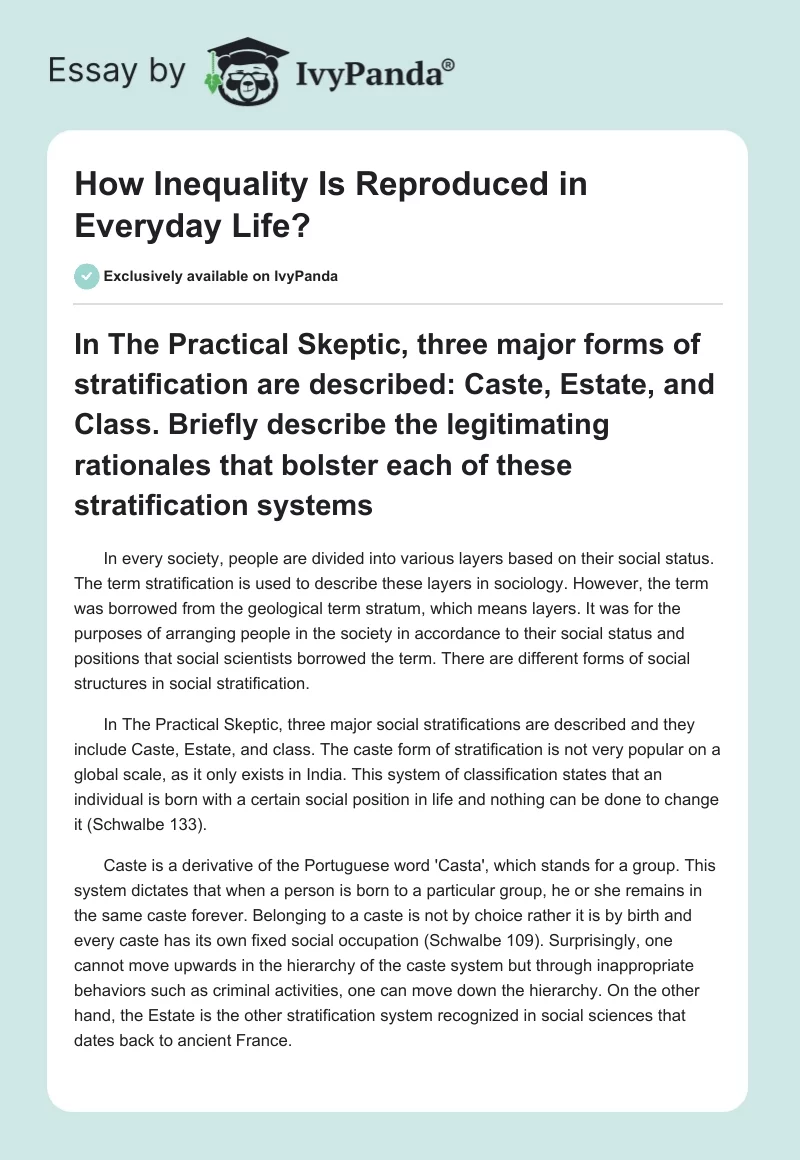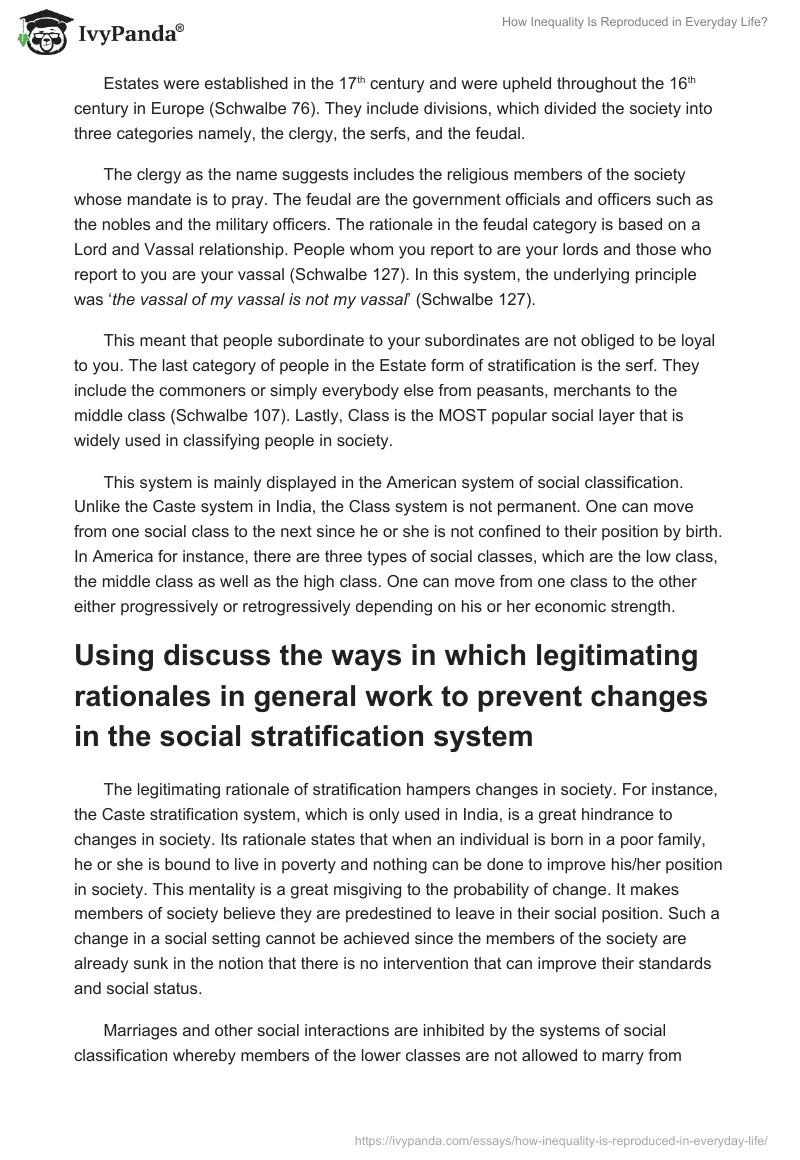In The Practical Skeptic, three major forms of stratification are described: Caste, Estate, and Class. Briefly describe the legitimating rationales that bolster each of these stratification systems
In every society, people are divided into various layers based on their social status. The term stratification is used to describe these layers in sociology. However, the term was borrowed from the geological term stratum, which means layers. It was for the purposes of arranging people in the society in accordance to their social status and positions that social scientists borrowed the term. There are different forms of social structures in social stratification.
In The Practical Skeptic, three major social stratifications are described and they include Caste, Estate, and class. The caste form of stratification is not very popular on a global scale, as it only exists in India. This system of classification states that an individual is born with a certain social position in life and nothing can be done to change it (Schwalbe 133).
Caste is a derivative of the Portuguese word ‘Casta’, which stands for a group. This system dictates that when a person is born to a particular group, he or she remains in the same caste forever. Belonging to a caste is not by choice rather it is by birth and every caste has its own fixed social occupation (Schwalbe 109). Surprisingly, one cannot move upwards in the hierarchy of the caste system but through inappropriate behaviors such as criminal activities, one can move down the hierarchy. On the other hand, the Estate is the other stratification system recognized in social sciences that dates back to ancient France.
Estates were established in the 17th century and were upheld throughout the 16th century in Europe (Schwalbe 76). They include divisions, which divided the society into three categories namely, the clergy, the serfs, and the feudal.
The clergy as the name suggests includes the religious members of the society whose mandate is to pray. The feudal are the government officials and officers such as the nobles and the military officers. The rationale in the feudal category is based on a Lord and Vassal relationship. People whom you report to are your lords and those who report to you are your vassal (Schwalbe 127). In this system, the underlying principle was ‘the vassal of my vassal is not my vassal’ (Schwalbe 127).
This meant that people subordinate to your subordinates are not obliged to be loyal to you. The last category of people in the Estate form of stratification is the serf. They include the commoners or simply everybody else from peasants, merchants to the middle class (Schwalbe 107). Lastly, Class is the MOST popular social layer that is widely used in classifying people in society.
This system is mainly displayed in the American system of social classification. Unlike the Caste system in India, the Class system is not permanent. One can move from one social class to the next since he or she is not confined to their position by birth. In America for instance, there are three types of social classes, which are the low class, the middle class as well as the high class. One can move from one class to the other either progressively or retrogressively depending on his or her economic strength.
Using discuss the ways in which legitimating rationales in general work to prevent changes in the social stratification system
The legitimating rationale of stratification hampers changes in society. For instance, the Caste stratification system, which is only used in India, is a great hindrance to changes in society. Its rationale states that when an individual is born in a poor family, he or she is bound to live in poverty and nothing can be done to improve his/her position in society. This mentality is a great misgiving to the probability of change. It makes members of society believe they are predestined to leave in their social position. Such a change in a social setting cannot be achieved since the members of the society are already sunk in the notion that there is no intervention that can improve their standards and social status.
Marriages and other social interactions are inhibited by the systems of social classification whereby members of the lower classes are not allowed to marry from families of the higher classes. Class separates the rich and the poor and access to certain resources are controlled and available to one side. It becomes very difficult for members in the lower class to change their social class due to lack of resources or access to them they cannot develop themselves from poverty. In America, the rich continue to get rich while the poor get poorer.
What is the basic function of social institutions in society? (Illustrate by using two examples of social institutions)
A social institution is an organization whose functions are dedicated to satisfying the basic human social needs. Such institutions are also responsible for defining dominant social values, establishing permanent patterns of human behavior, clearly outlining the roles of individuals among other functions (McIntyre 96). Examples of social institutions include the government and family. The government is a social institution that has great responsibilities.
This institution is responsible for enforcing laws, adjudication of conflicts, improving the welfare of its people, protecting the society from external and internal threats among other legislative functions (McIntyre 95). The family on the other hand provides new members of the society through having children. In addition, the family is responsible for controlling society’s sexual behaviors and manages the economic and emotional state of the society (McIntyre 96).
List at least five of the statuses that you occupy. Indicate whether each status is achieved or ascribed. Explain how you distinguish between ascribed and achieved statuses
Status is defined as an individual’s position in society. My statuses in society are both achieved and ascribed. I am a student, an elder brother, a guitarist, a child of my parents, and a basketball player. These positions can either be achieved or ascribed depending on the nature of the status. An achieved status is based on merit or through an individual’s effort while the ascribed status is beyond his or her control and comes naturally.
Achieved status is realized through learning or training but the ascribed status is naturally acquired. In my society, I am a child of my parents and this position is ascribed. Other ascribed statuses that I possess include being a male, and an elder brother to my siblings. On the other hand, I have the achieved statuses, which include being a university student, a guitarist, and a basketball player. My social skills have enabled me to become a better leader since I have learned to live with people and handle them. Social statuses come with great responsibilities and obligations (McIntyre 98).
Every status has its behavioral requirements that one has to uphold. Being a student requires one to display some level of discipline and respect for authority. Being a firstborn in a family comes naturally and the roles and responsibilities therein are automatic. Firstborns are expected to be an example to the rest of the siblings. Statuses come with distinct responsibilities and expectations from society and for one to maintain a status he or she must be willing to meet the standards set to define that status. For the natural statuses, one does not have to work hard to maintain them since they are God-given. If a person is tall or short, it is a natural gift that can be taken away from him or her.
Works Cited
McIntyre, Lisa. The Practical Skeptic: Core Concepts in Sociology, New York, NY: McGraw-Hill Humanities/Social Sciences, 2010.Print.
Schwalbe, Michael. Rigging the Game: How Inequality Is Reproduced in Everyday Life, Oxford, UK: Oxford University Press, 2007. Print.


